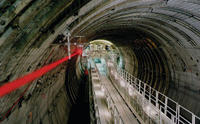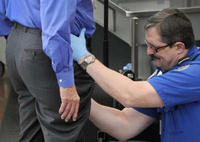-
Iran pushes ahead with nuke plans, despite seismic warnings
Iranian officials have chosen to ignore the warnings of top scientists and continue with the construction of nuclear facilities near earthquake prone regions; according to an official with the International Atomic Energy Agency, in a top level meeting Iran’s leaders recently decided to move ahead with plans to construct nuclear facilities, despite Iranian scientists’ warnings that “data collected since the year 2000 shows the incontrovertible risks of establishing nuclear sites in the proximity of fault lines’ in Khuzestan as well as nineteen other Iranian provinces; Iran is one of the most seismically active countries in the world with major fault lines covering at least 90 percent of it
-
-
Smiths Detection wins two government contracts
The Department of Defense (DoD) recently awarded Smiths Detection a $30 million contract to supply the military with chemical detection devices; under the contract Smiths Detection will provide its newly enhanced M4A1 JCADs, a portable detection device that weighs less than two pounds and warns of the presence of any dangerous chemical warfare agents or toxic chemicals; Smiths Detection also received a 16 million Euro contract from the German Federal Ministry of Finance to provide X-ray scanners for cargo systems
-
-
Sector Report for Monday, 6 June 2011: Detection
This report contains the following stories.
-
-
Bomb sniffing dogs deployed to Long Island ferry
A New York ferry company has become the first in the United States to receive federal grants to pay for the deployment of explosive detection canine teams; the Bridgeport & Port Jefferson Steamboat Company is teaming up with Long Island K-9 service to use bomb sniffing dogs to detect any explosives aboard the ferries; the canine teams will inspect every car that enters the ferry; teams were initially deployed on 13 May and the contract will last for three years
-
-
Bacteria designed for sleuthing
Seven Cambridge University undergraduates spent the summer of 2009 genetically engineering bacteria to secrete a variety of colored pigments, visible to the naked eye; they designed standardized sequences of DNA, known as BioBricks, and inserted them into E. coli bacteria — so the bacteria can now change its color to red, yellow, green, blue, brown, or violet; the bacteria can be programmed to do useful things, such as indicate whether drinking water is safe by turning red if they sense a toxin; other uses for the design bacterium include monitoring food additives, patenting issues, personalized medicine, terrorism, and new types of weather
-
-
Japanese firms purchase radiation detection devices
Universal Detection Technology (UNDT) recently announced that it has shipped radiation detection devices to companies across Japan including those in heavy industries, telecommunications, and electronics; according to UNDT, Japanese companies have been purchasing a range of devices including dosimeter systems to measure cumulative radiation exposure and advanced survey meters and surface monitors that detect the amount of contamination on surfaces
-
-
Glimmer of hope for Yucca Mountain nuclear waste repository project

Over the last twenty-five years, the United States has spent around $15 billion on the Yucca Mountain Nuclear Waste Repository which was supposed to offer a solution to the growing nuclear waste problems at U.S. nuclear power plants; in what some charged was a political move by President Barack Obama to secure Nevada’s Democratic tilt, the administration defunded the project, and funding for work on the site was terminated altogether effective with the 2011 federal budget passed by Congress on 14 April 2011; some in Congress want the project to continue, and the House Appropriations Committee has added $35 million for the project in the 2012 energy spending bill; this is far cry from past appropriations for the project — typically around $400 million a year — and even one of the supporters, Representative Mark Simpson (R-Idaho) described it as symbolic gesture; there is also a case now being heard in federal court, in which the administration is charged with overstepping its bounds by cancelling the project without congressional permission
-
-
WikiLeaks: Japan brushes aside U.S. fears of nuke terrorism
Diplomatic cables obtained by WikiLeaks reveal that U.S. officials were concerned about terrorist attacks at Japan’s nuclear facilities and the government’s seemingly lax security measures; one cable dated 26 February 2007, detailed a meeting where Japanese officials brushed aside U.S. concerns for physical security at one of the country’s nuclear facilities; additional cables sent from the U.S. Embassy in Tokyo to Washington D.C. reported that anti-terrorism drills held at nuclear facilities were unrealistic and overly “scripted”
-
-
Floyd County gets additional $75,000 for CBRNE unit
Floyd County in Georgia has received two DHS grants worth $75,000 to replace and repair equipment for its chemical, biological, radiological, nuclear, and explosives (CBRNE) response unit; the bulk of the money, approximately $65,000, will go towards replacing aging equipment, while the rest will go towards repairs; the CBRNE team was originally created four years ago with nearly $350,000 in DHS funding as part of the state’s terrorism prevention initiative
-
-
Agreement reached on European Union stress tests
Yesterday European Union officials reached an agreement on the parameters of nuclear stress tests and will soon begin conducting safety reviews at nuclear power plants; the tests will review the resiliency of 143 nuclear facilities in the face of natural disasters like earthquakes and tornadoes in addition to terrorist attacks; the move to conduct safety reviews was triggered by the ongoing nuclear crisis in Japan; events in Japan sparked anti-nuclear protests across Europe and leaders have called for a “comprehensive and transparent risk and safety assessment” at all atomic energy facilities in the European Union
-
-
Simple method of dealing with harmful radioactive iodine discovered
Iodine radioisotopes are produced by fission of uranium fuel in a nuclear reactor; radioactive iodine is of concern because it is highly mobile in the environment and selective uptake by the thyroid gland can pose a significant cancer risk following long term exposure; furthermore, iodine-129, which is a type of radioactive iodine, has an extremely long half life of 15.7 million years, so is one of the most significant long term hazards faced by the population due to its emission during the geological disposal of nuclear waste; a University of Sheffield expert has discovered a novel way to immobilize radioactive forms of iodine using a microwave
-
-
Following Fukushima: how much radioactivity in the Oceans?
A result of the loss of electricity at the Fukushima nuclear plant in Japan on 11 March, overheating led to significant releases of iodine, cesium, and other radioisotopes to the environment; Japanese officials recently raised the severity of the nuclear power plant incident to level 7, the highest level on the international scale and comparable only to the Chernobyl incident twenty-five years ago; the National Science Foundation awards rapid-response grants to establish ocean radionuclide levels from Fukushima
-
-
EU nearing agreement on nuclear stress tests
The European Union could begin stress-testing its nuclear reactors as early as June 1; officials are nearing an agreement on the parameters for safety tests, but are still hammering out the last “two or three” issues; following the nuclear disaster at the Fukushima Daiichi nuclear plant in Japan, European energy officials as well as industry groups have been pushing the government to conduct stress tests on its nuclear facilities to determine how they will fare in various disaster scenarios; EU Energy Commissioner Guenther Oettinger has sought to include threats from terrorist attacks as well as cyber attacks, which has stalled stressed test negotiations
-
-
Scientists continue to raise doubts about safety of full body scanners
The controversy over the Transportation Security Administration’s (TSA) body scanners lingers on as scientists continue to question the safety of these devices that expose millions of people to trace amounts of radiation; TSA officials maintain that their full body x-ray scanners are safe as they only expose individuals to negligible amounts of radiation, the equivalent of two minutes of flying; despite these assurances, a group of five scientists recently sent an open letter to the White House Science advisor; the scientists argue that the tests used to validate TSA’s claims contain critical flaws, lack transparency, and have not been independently verified
-
-
Texas House prohibits intrusive airport pat downs

The Texas House of Representatives approved a bill that would make invasive pat downs at airports a crime; pat down procedures that would be covered under the measure are inspections that touch the anus, sexual organ, buttocks, or breast of another person including through the clothing, or touches the other person in a manner that would be offensive to a reasonable person; the law would not be enforceable since state legislatures have no authority over federal agencies such as the TSA
-
- All
- Regional
- Water
- Biometrics
- Borders/Immig
- Business
- Cybersecurity
- Detection
- Disasters
- Government
- Infrastructure
- International
- Public health
- Public Safety
- Communication interoperabillity
- Emergency services
- Emergency medical services
- Fire
- First response
- IEDs
- Law Enforcement
- Law Enforcement Technology
- Military technology
- Nonlethal weapons
- Nuclear weapons
- Personal protection equipment
- Police
- Notification /alert systems
- Situational awareness
- Weapons systems
- Sci-Tech
- Sector Reports
- Surveillance
- Transportation
Advertising & Marketing: advertise@newswirepubs.com
Editorial: editor@newswirepubs.com
General: info@newswirepubs.com
2010-2011 © News Wire Publications, LLC News Wire Publications, LLC
220 Old Country Road | Suite 200 | Mineola | New York | 11501
Permissions and Policies
Editorial: editor@newswirepubs.com
General: info@newswirepubs.com
2010-2011 © News Wire Publications, LLC News Wire Publications, LLC
220 Old Country Road | Suite 200 | Mineola | New York | 11501
Permissions and Policies
